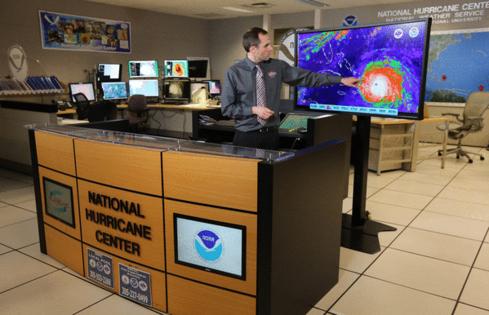With hurricane season ahead, Trump cuts leave Florida weather offices understaffed
Published in Weather News
MIAMI — With hurricane season only weeks away, federal budget cuts have left key Florida weather offices understaffed, and former employees worry that additional proposed reductions to staff and research could compromise not only accurate forecasts but potentially public safety.
A suggested federal budget from the Donald Trump administration calls for a deep cut — about 27% — to the National Oceanic and Atmospheric Administration, which oversees the Miami-based National Hurricane Center. It would also drain the budget for agencies that help understand the impacts of climate change.
In an open letter last week, every living former head of the National Weather Service said they were “deeply concerned” about the current and proposed cuts. They warned that more than 550 employees have left NWS in recent weeks, either via buyout offers or terminations.
“That leaves the nation’s official weather forecasting entity at a significant deficit — down more than 10% of its staffing — just as we head into the busiest time for severe storm predictions like tornadoes and hurricanes,” they wrote.
“Our worst nightmare is that weather forecast offices will be so understaffed that there will be needless loss of life.”
Florida weather offices collectively appear to be down 16 employees, the Miami Herald found. And even more vacancies remain unfilled.
However, the exact toll of the administration’s many actions is hard to understand, both because agencies won’t answer questions about it and because policy continues to whiplash back and forth.
NOAA and NWS spokespeople declined to answer specific questions and instead provided the same statement.
“NOAA remains dedicated to its mission, providing timely information, research, and resources that serve the American public and ensure our nation’s environmental and economic resilience. We continue to provide weather information, forecasts and warnings pursuant to our public safety mission,” the agency said.
The mass firing of many researchers and staffers at NOAA was — briefly — reversed under court order, then the employees were laid off again. That includes five employees who work on the vaunted hurricane hunters team, the researchers who fly planes into storms. Three of those employees, all flight crew members, have been reinstated. Two more, who helped with maintenance and paperwork to keep the planes safely in the air, have not.
Contracts with outside parties have lapsed, then been re-signed into action by NOAA authorities.
For instance, a contract to translate crucial weather forecasts into Spanish and other languages expired in April, but a few weeks later, the agency renewed the contract. This season, updates will be available in both English and Spanish, as well as several other languages.
The Southeastern Regional Climate Center, which provides weather data to NOAA, temporarily stopped transmitting the data that helps weather offices across Florida create forecasts for a few days until the agency renewed its contract.
Florida’s missing meteorologists
NWS offices — where residents first hear warnings about flash floods, extreme heat days and how, precisely, an imminent hurricane will affect them — are understaffed across Florida. Vacancies remain unfilled, and a combination of cuts ordered by the controversial Department of Government Efficiency, spearheaded by billionaire Elon Musk, retirements and other departures has pared down the state’s top weather scientists.
The Miami office appears to be down three meteorologists and a technician, compared to September staffing. The Keys office is down three meteorologists from last September. Tallahassee seems to have lost three meteorologists, and Jacksonville has two new vacancies.
It’s part of a national trend. Twenty-five different NWS offices nationwide now lack a meteorologist-in-charge, the top scientist, compared to seven such vacancies in September, per NWS records updated this week.
That includes Tampa Bay, which got slammed with two destructive storms last summer, flooding thousands of homes. The office is also down four staff members, compared to September. Vacancies also remain unfilled at each office.
The National Hurricane Center fared better than its weather service colleagues. A review of past versus current staffing shows only one fewer meteorologist and three fewer support staff. The Hurricane Research Division appears to have lost zero staffers — at least, for the moment.
An additional round of early retirements on April 30 may not be reflected in these staffing totals.
Those staffing cuts have led to material changes at weather offices around the country. Some have stopped monitoring the weather 24/7, including in regions with high tornado risk, and others have been unable to launch the twice-daily weather balloons that feed important weather data into the massive models that help predict everything from rain to hurricanes.
So far, only a handful of offices have stopped or slowed the weather balloon launches, including sites in Alaska, Nebraska and South Dakota. Tallahassee stopped weather balloon launches last summer due to a shortage of helium, unrelated to recent government cuts.
So far, experts say, these cuts aren’t yet affecting the agencies’ ability to forecast weather and storms, but additional cuts could raise the likelihood of that happening.
Andrew Hazelton, a former physical scientist at NWS who was fired in the first round of federal cuts, said he’s concerned that some of the current and proposed cuts could “cripple” the federal government’s ability to keep improving its hurricane and weather forecasts.
“It’s not like the models are going to stop running, but the ability to test and improve them could go away,” he said. “The impacts of that may not be felt right away, but they’ll definitely be felt down the line.”
The height of his concerns is a repeat of a situation like 2023’s Hurricane Otis in Acapulco, Mexico or Hurricane Oscar in Cuba last year. Both times, the National Hurricane Center didn’t have proper data or enough Hurricane Hunter flights into the storm and underestimated its impacts. Otis exploded from a tropical storm by morning to a nightmare Category 5 by the evening, an expected hit for the coastal city.
“You’d like to think, with the tech we have, no, we wouldn’t let that happen, but if there’s enough cuts and degradation to our ability, I don’t think we can rule it out,” Hazelton said.
Trump budget request would cut deeper
The cuts also could continue in coming years. The Trump administration’s proposed budget for the upcoming fiscal year dramatically slashes the budget for many federal agencies, including NOAA.
The document explicitly calls for ending most programs that address or monitor climate change, “which are not aligned with Administration policy-ending ‘Green New Deal’ initiatives.” The agency has been monitoring the potential impacts of climate change for decades, long before the Green New Deal policy proposal was suggested in 2019.
The budget also cuts educational grants from NOAA, which it says have “consistently funded efforts to radicalize students against markets and spread environmental alarm.”
John Cortinas, the former deputy assistant administrator for science at NOAA, called it the biggest threat to the agency’s budget and scientific ability he’s ever seen.
“I’ve been associated with NOAA for 30 years and I’ve never seen anything like it,” he said.
The proposed budget calls for breaking up NOAA’s Oceanic and Atmospheric Research arm, an idea that was considered twenty years ago, before a federal panel eventually determined that it was a bad idea. Cortinas said the panel found that dividing up the agency’s research arm would starve funding for new research over time.
That research has proposed increasingly accurate weather and storm forecasts. A five-day forecast for an upcoming hurricane is now as accurate as the one to two-day forecasts were in 1992, when Hurricane Andrew was bearing down on Florida.
In 2023, NOAA introduced a brand-new hurricane model — HAFS — that quickly became a top tool in understanding imminent storms. The president’s proposed budget includes cuts to the agencies and researchers who are working on the next version of these models and tools. Cortinas said.
“By losing people, we’re not able to improve the hurricane forecast model that the weather service uses today,” he said. “By delaying that, the public is going to be delayed in getting a better forecast.”
While Congress has yet to weigh in on whether it will accept the president’s proposed budget as is, Cortinas said current NOAA staffers are terrified they could lose their jobs any day.
“It puts people on pins and needles every day to think, ‘Is this the day I lose my job? Am I next?” he said.
©2025 Miami Herald. Visit at miamiherald.com. Distributed by Tribune Content Agency, LLC.







Comments